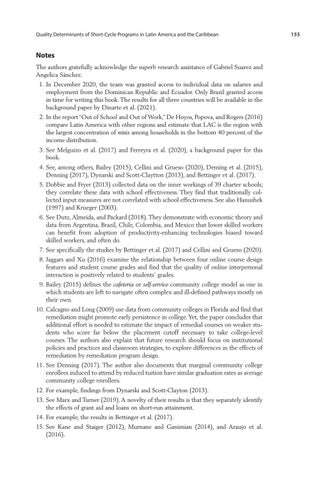Quality Determinants of Short-Cycle Programs in Latin America and the Caribbean
Notes The authors gratefully acknowledge the superb research assistance of Gabriel Suarez and Angelica Sánchez. 1. In December 2020, the team was granted access to individual data on salaries and employment from the Dominican Republic and Ecuador. Only Brazil granted access in time for writing this book. The results for all three countries will be available in the background paper by Dinarte et al. (2021). 2. In the report “Out of School and Out of Work,” De Hoyos, Popova, and Rogers (2016) compare Latin America with other regions and estimate that LAC is the region with the largest concentration of ninis among households in the bottom 40 percent of the income distribution. 3. See Melguizo et al. (2017) and Ferreyra et al. (2020), a background paper for this book. 4. See, among others, Bailey (2015), Cellini and Grueso (2020), Deming et al. (2015), Denning (2017), Dynarski and Scott-Claytton (2013), and Bettinger et al. (2017). 5. Dobbie and Fryer (2013) collected data on the inner workings of 39 charter schools; they correlate these data with school effectiveness. They find that traditionally collected input measures are not correlated with school effectiveness. See also Hanushek (1997) and Krueger (2003). 6. See Dutz, Almeida, and Packard (2018). They demonstrate with economic theory and data from Argentina, Brazil, Chile, Colombia, and Mexico that lower skilled workers can benefit from adoption of productivity-enhancing technologies biased toward skilled workers, and often do. 7. See specifically the studies by Bettinger et al. (2017) and Cellini and Grueso (2020). 8. Jaggars and Xu (2016) examine the relationship between four online course design features and student course grades and find that the quality of online interpersonal interaction is positively related to students’ grades. 9. Bailey (2015) defines the cafeteria or self-service community college model as one in which students are left to navigate often complex and ill-defined pathways mostly on their own. 10. Calcagno and Long (2009) use data from community colleges in Florida and find that remediation might promote early persistence in college. Yet, the paper concludes that additional effort is needed to estimate the impact of remedial courses on weaker students who score far below the placement cutoff necessary to take college-level courses. The authors also explain that future research should focus on institutional policies and practices and classroom strategies, to explore differences in the effects of remediation by remediation program design. 11. See Denning (2017). The author also documents that marginal community college enrollees induced to attend by reduced tuition have similar graduation rates as average community college enrollees. 12. For example, findings from Dynarski and Scott-Clayton (2013). 13. See Marx and Turner (2019). A novelty of their results is that they separately identify the effects of grant aid and loans on short-run attainment. 14. For example, the results in Bettinger et al. (2017). 15. See Kane and Staiger (2012), Murnane and Ganimian (2014), and Araujo et al. (2016).
155

